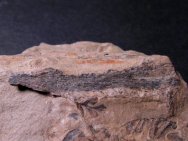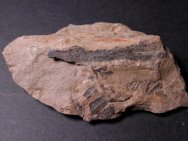|
 During
most of the Pennsylvanian (325 to 286 million years ago), long
before the dinosaurs, a large portion of North America supported
lush, swampy forests. Lycopods made up the largest component
of these forests and achieved gigantic size, growing to heights
of more than 130 feet with supporting trunks measuring up to
6 feet or more in diameter. These plants are also called "scale
trees" because of the distinctive diamond-shaped leaf
scars that cover their outer bark midsection. Neuropteris,
Sphenopteris, and Lyginopteris were three of the many of genus
of pteridosperms or seed ferns. The seed ferns had undergone
a large radiation, and many, many species existed, most of
which have not been scientifically described in the fossil
record. Now extinct, these diverse plants had foliage closely
resembling that of modern ferns, but they reproduced by means
of seeds rather than spores as modern ferns do today. The period
from the Mississippian through the Pennsylvanian is During
most of the Pennsylvanian (325 to 286 million years ago), long
before the dinosaurs, a large portion of North America supported
lush, swampy forests. Lycopods made up the largest component
of these forests and achieved gigantic size, growing to heights
of more than 130 feet with supporting trunks measuring up to
6 feet or more in diameter. These plants are also called "scale
trees" because of the distinctive diamond-shaped leaf
scars that cover their outer bark midsection. Neuropteris,
Sphenopteris, and Lyginopteris were three of the many of genus
of pteridosperms or seed ferns. The seed ferns had undergone
a large radiation, and many, many species existed, most of
which have not been scientifically described in the fossil
record. Now extinct, these diverse plants had foliage closely
resembling that of modern ferns, but they reproduced by means
of seeds rather than spores as modern ferns do today. The period
from the Mississippian through the Pennsylvanian is often called
the Age of Ferns. often called
the Age of Ferns.
Growing
in the shade of the immense tree ferns were herbaceous, spore-producing
plants, the Lycopodiales like the fossil plants you see here.
These primitive plants that are believed to have first appeared
in the Devonian have extant relatives commonly called club mosses
- an example of a modern species is shown to the right.
The
Lycopodiales here are from a new locality, recently determined
by scientists to be part of the Fire Creek Formation, located
in Southeastern West Virginia (the formation overlays the Pocahontas
Formation that also contains a prominent coal seam). The pictures
attest to the fine preservation. This genus of plant is very
uncommon in the formation. The
Lycopod in in association with a few Neuopteris leaflets of undescribed
species.
|



